
When Matthew Eledge and his husband, Elliot Dougherty, told Matthew’s mother, Cecile, that they were planning to start their family, Cecile thought fondly of her own parental journey. She’d loved being pregnant decades earlier with her three now-grown children.
“If you want me to be the gestational carrier,” she told Matthew, “I’d do it in a heartbeat.”
Matthew, 32, and Elliot, 29, appreciated the gesture, but, they thought, let’s be real — it’s not like that would ever happen. A postmenopausal 61-year-old couldn’t possibly be equipped to carry and give birth to a baby. Right?
But when Matthew and Elliot, who live in Omaha, Nebraska, were meeting with reproductive endocrinologists to discuss surrogacy options, Matthew mentioned his mother’s joking offer — and their doctor, Dr. Carolyn Maud Doherty, didn’t think it sounded like much of a joke at all. There weren’t any guarantees, but Doherty was game to see whether Matthew’s mother might be a serious candidate for surrogacy.
Cecile’s children always teased her for being such a health fanatic, committed to a good diet and regular exercise, but as it turned out, a lifetime of diligence paid off. The team from the Reproductive Health Specialists at Methodist Women’s Hospital in Omaha ran a Pap smear, a blood test, a cholesterol test, a stress test, a mammogram, and an ultrasound, all of which revealed Cecile to be in tip-top shape — healthy enough, the doctors deemed, to potentially carry a fetus to term.
“She’s 61 years old and has lower blood pressure than the rest of us,” Matthew joked. “When they made her run on a treadmill, even when it was turned up to the highest level, she wasn’t anywhere close to the danger zone.”
“I thought if I could do it, I would do it,” Cecile told me. “It was kind of a no-brainer.”
Carrying one’s own biological grandchild may seem like the stuff of science fiction, but Cecile isn’t the first, or even the oldest, woman to do it. However, Doherty told me that “it’s important for people to note that not every 60-year-old is in good enough health to be a surrogate. There are probably only a handful of people across the country who can do this — only a handful of people who have done it.”
“I thought if I could do it, I would do it. It was kind of a no-brainer.”
In South Africa, in 1987, 48-year-old Pat Anthony gave birth to three of her own biological grandchildren as triplets — causing an international media firestorm, and stirring up debates surrounding the ethics of surrogate pregnancy. A number of other grandparents have done the same in the US and around the globe. A 67-year-old Greek grandmother, Anastassia Ontou, gave birth to her daughter’s baby in 2016, making her the oldest known surrogate in the world.
Doherty noted that there are higher risks associated with older surrogates, which can include pulmonary problems, blood clots, and a likelier chance of needing a C-section, “because bones just don’t move the way they did when they were younger.” Pamela Butler in Britain was 57 when she gave birth to her grandson after four rounds of in vitro fertilization (IVF) treatment, which is a stressful, very expensive process that can be challenging at any age. Ontou had a C-section following seven and a half months of pregnancy; at birth, the baby weighed just 2.16 pounds.
But Cecile? She got pregnant after her very first embryo transfer — using an egg donated by Elliot’s sister Lea Yribe, who was 25 at the time, and fertilized with Matthew’s sperm. And this past weekend, after more than two years of planning and preparation, at 6:06 a.m. on March 25, she gave birth (no C-section needed) to her first granddaughter, Uma Louise Dougherty-Eledge. Clocking in at 5 pounds, 13 ounces, Uma is a sweet and healthy baby girl.
Cecile “really sailed through this with no complications,” said Doherty.
“We’re very, very lucky,” Matthew said.
Even so, Matthew and Elliot’s road to parenthood hasn’t been without obstacles, as other LGBT parents around the country — and particularly in Nebraska — can attest. But the couple wanted to share their story, in part to prove that a family like theirs can thrive anywhere, even in the conservative heartland of the US.
The seed of an idea that eventually became Uma was planted while Matthew and Elliot were on a backpacking trip in Eastern Europe a few years ago. Holed up together in their hostel, writing and drawing, avoiding the turmoil of the world outside, they “created this kind of sanctuary,” Matthew said. “And we realized we could do this with each other.” This: Be together. Start a family.
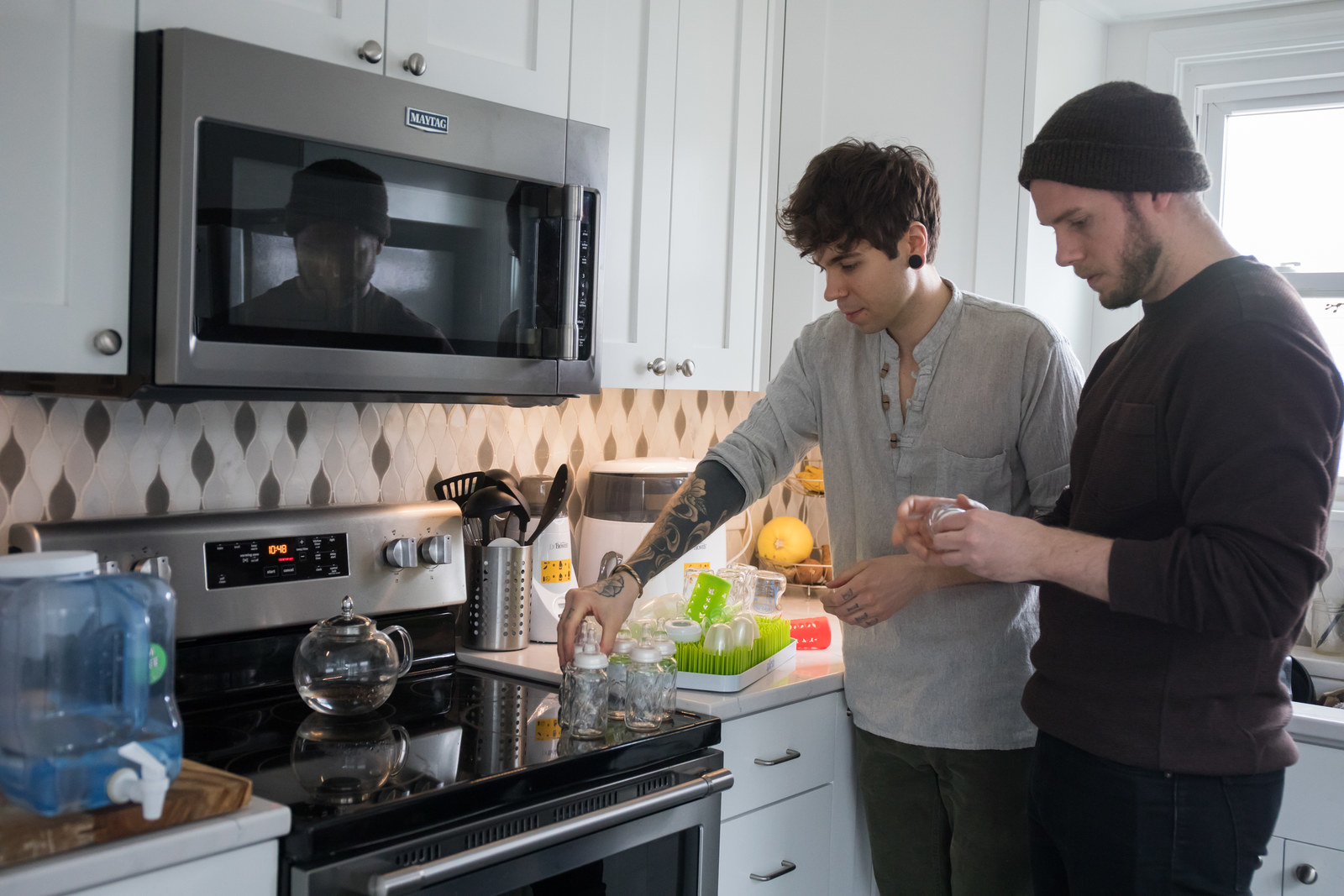
When Matthew and Elliot were first considering IVF a couple years ago, they were still smarting from Matthew’s experience with LGBT discrimination in the workplace.
In April 2015, he was fired from his position as an English teacher and speech coach at a private Catholic high school in Omaha after he informed the school that he and Elliot planned to get married. The firing prompted a petition against the school’s actions that garnered over 100,000 signatures. (He now teaches at a different public school.)
Nebraska has no state laws banning discrimination based on sexual orientation or gender identity. Earlier this month, a bill attempting to change that hit a dead end. There’s currently other pro-LGBT bills in the state legislature, including one to ban conversion therapy. Megan Hunt, the first openly LGBT person ever elected to the Nebraska legislature, just introduced LB-501, which would require insurance providers to cover reproductive health procedures like IVF. But all of these bills will likely face an uphill battle in a state senate with nearly twice as many Republican members as Democrats.
Each cycle of egg retrieval and transfer can cost about $12,000, which the family only had to pay once, since Cecile got pregnant on the first try.
For now, Nebraska remains a tough place for a queer family to find their footing. And in Nebraska, as it is elsewhere around the country, the various procedures involved in IVF are often only partly covered by insurance plans, if they’re covered at all. Matthew and Elliot weren’t covered, and they estimate they spent about $40,000 on IVF alone.
“And that’s literally the cheapest it could have been,” said Matthew. Each cycle of egg retrieval and transfer can cost about $12,000, which the family only had to pay once, since Cecile got pregnant on the first try. Plus, they didn’t have to pay tens of thousands of dollars for donated eggs, since Elliot’s sister, Lea, donated them for free. But in addition to the costs of IVF, they also had to cover all the expenses associated with Cecile carrying and birthing the baby; if she were giving birth to her own child, rather than her grandchild, insurance would have kicked in for some of those expenses. But as a surrogate, the family’s insurance wouldn’t cover any pregnancy-related fees. For a teacher and a hairdresser like Matthew and Elliot, these costs were exorbitant.
“I do think it’s sad that IVF as a process is exclusive to those who can afford it,” Matthew said. “And for queer couples, it’s a particular challenge.” But he acknowledged that this is a tricky subject. IVF isn’t quite like other reproductive health procedures that many think everyone should have free or subsidized access to, from cancer screenings to birth control and abortion. Should citizens “have a right to make life?”
Knowing how much it would cost to have a baby, Matthew and Elliot had been saving for Uma’s arrival for years. Elliot’s more of the planner (“he’s much smarter than I am,” Matthew joked), and Elliot said he had to get comfortable “being really open to the unknown.” Because Matthew’s mom was doing something “so innovative and new” — and she’s an older gestational carrier — “any moment could become a huge financial situation,” Elliot added. “When we found out insurance wouldn’t cover anything, we thought this could be something that affects us financially for a really long time.”
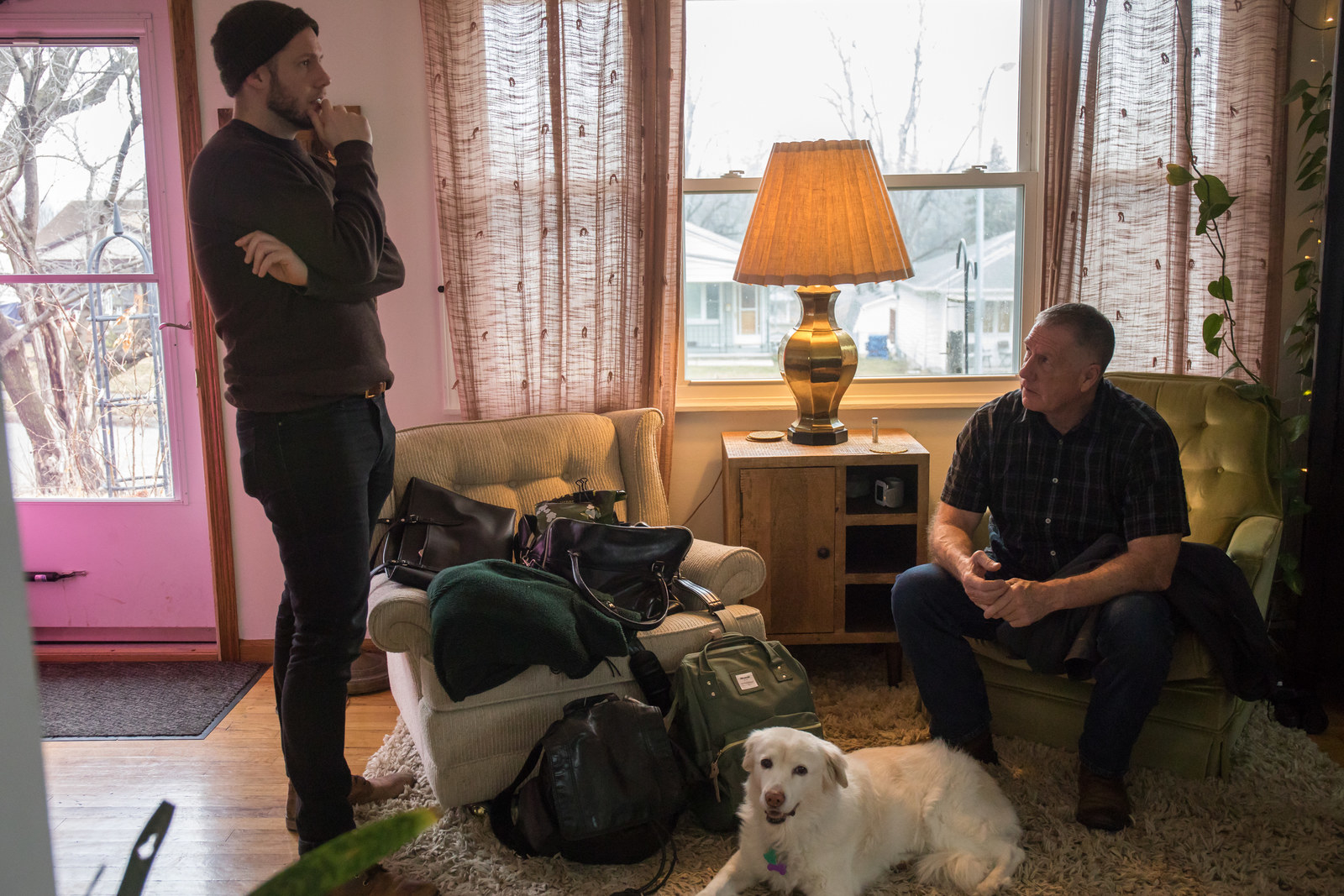
Before Elliot and Matthew asked Elliot’s sister, Lea, about the possibility of donating her eggs, “I had already told them I would do whatever I could,” Lea told me. “When they did get serious about it, it wasn’t a question — though of course I had to talk to my husband, and he was very open to the idea.”
Matthew and Elliot were overjoyed — not only because Elliot would be genetically connected to the baby, but because the age of donated eggs is one of the most significant factors in creating a viable embryo, and Lea was just 25 at the time. Plus, she’d already had one child and was expecting a second, as sure a sign of fertility as any.
After early consultations, Matthew’s sperm needed to be frozen and quarantined for six months so it could be screened for HIV and other diseases. A couple months after Lea had her own baby, she began taking shots to stimulate her ovaries for egg donation.
“There are probably only a handful of people across the country who can do this — only a handful of people who have done it.”
“It was harder than I thought it was going to be,” Lea said. “I definitely knew there were going to be shots every day, but it was kind of stressful — you have to do it at the same time every day, which is tough when you have two kids running around. It took a toll on me. But in the end it wasn’t too bad. And it did make me feel for all the couples who have to go through this.”
The retrieval yielded about two dozen eggs, 11 of which were injected with Matthew’s sperm. After waiting five days for the embryos to develop, seven embryos had been successfully fertilized.
By that point, the couple decided to pay extra for preimplantation genetic testing, which would help determine the embryos most likely to develop into a healthy baby. After those tests, Matthew and Elliot were left with just three viable embryos.
Matthew said that he and Elliot had mixed feelings about the genetic testing. “You can find out the sex in that process,” he said, a choice that made them uncomfortable. “I’m not a super religious person, but you do feel like you’re playing God. Like, am I choosing too much?”
“I’d always dreamed of having a girl,” Matthew said, but he couldn’t bring himself to tip the scales of fate and request that an embryo with XX chromosomes be implanted rather than one with XY; rather, he requested that the doctors choose whichever embryo looked the healthiest. In the end, it didn’t matter — all three embryos were female.
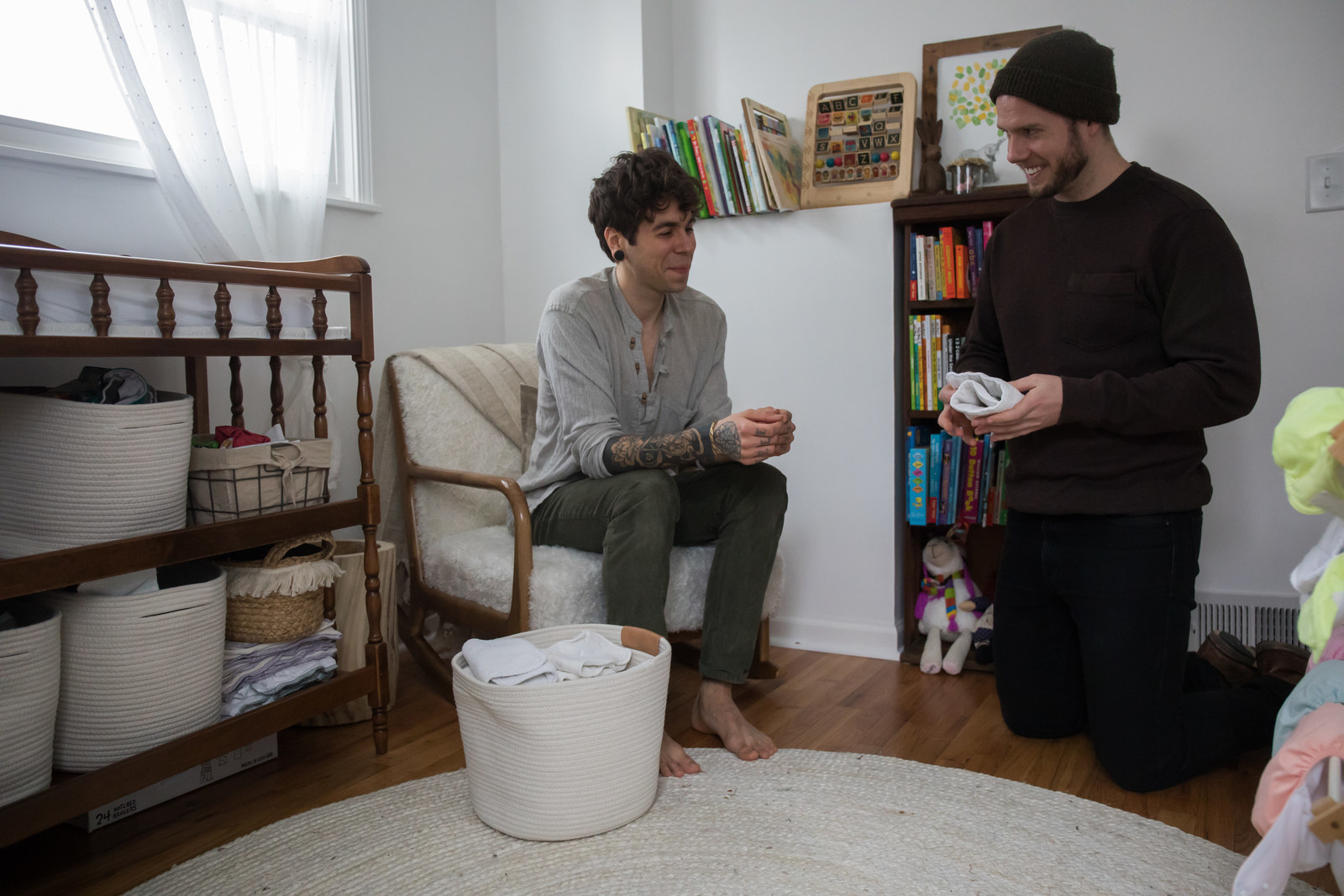
Now, of those three, “One is here!” Matthew said — and that’s Uma. The other two are “on ice” in case the couple should want to expand their family.
“It’s this weird thing,” Matthew said. “They’re just this bundle of cells, right? But now I’m like, ‘How can you discard those?’” They spent so much money and effort creating the embryos, and transferring them in the future would be much cheaper, since they wouldn’t have to pay for the egg retrieval process all over again. For now, Matthew and Elliot are keeping their options open.
The couple was also grateful to Lea for her donation because it meant they could avoid the weirdness of shopping for eggs donated by strangers, which had also made them feel like they were getting into designer baby territory. Keeping their embryo creation process in the family “took away the choice,” said Matthew.
The couple had previously considered fostering or adopting — options they’re very open to when it comes to building out their family in the future. And in choosing the IVF route instead, Matthew said, “you have to navigate this guilt. Like, why do we want to have a genetic connection? Are we just obsessed with ourselves? Are we trying to be heteronormative, to be just like a straight couple?” But, he said, “For us, it was about control.”
They knew that, no matter what, their route to having kids would be expensive and time-consuming; with IVF, Matthew and Elliot wouldn’t have to deal with potential bigotry from adoption agencies in Nebraska. As of only two years ago, the state banned same-sex couples from fostering children at all. Did they really want people coming to their home, determining whether they were fit to be parents?
Thanks to Lea and Matthew’s mom, he said, “We could do this on our own terms.”
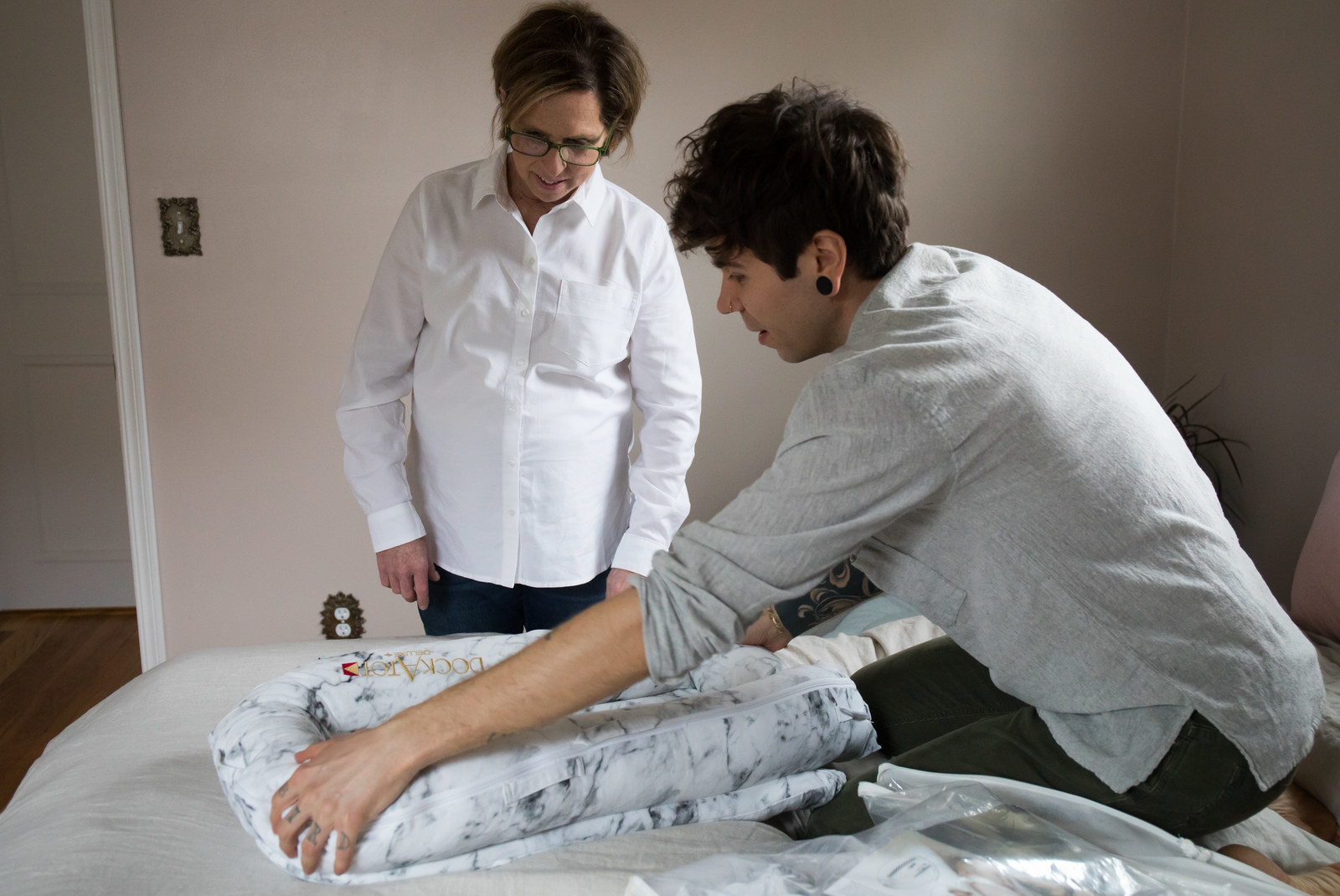
With eggs secured and Matthew’s sperm cleared for takeoff, Cecile was put on estrogen, which meant she had her period again after 10 postmenopausal years. (“It was certainly strange,” Cecile said, laughing, “but I kept remembering it was only temporary.”) Last summer, she got suited up for her first — and what would turn out to be her only — embryo transfer.
Some people, to “get more bang for their buck,” as Matthew put it, will try implanting multiple embryos at once, hoping at least one will stick, which can sometimes lead to multiple pregnancies. He was grateful to Dr. Doherty for encouraging him and Elliot to try implanting just one embryo — it would be worth the potential failure to ensure that his mother would only have to deliver one child.
No matter the age of the person hoping to get pregnant, “we always recommend using one embryo,” said Doherty. “Multiple gestations would mean an escalated risk of hypertension, preeclampsia, and C-sections.” Pregnancy is hard enough on the body without accounting for the possibility of twins or triplets growing in a 61-year-old uterus.
“You have to navigate this guilt. Like, why do we want to have a genetic connection? Are we trying to be heteronormative, to be just like a straight couple?”
After the transfer, “I was a wreck,” Matthew said. They were told to wait at least two weeks before checking to see if the cycle had been successful, but “of course I wasn’t gonna do that.” He bought one of the most expensive over-the-counter pregnancy tests available and drove it over to his mother’s house. He remembers thinking that the stakes felt so high: They only had three viable embryos to work with, and he didn’t want his mom to feel disappointed or somehow at fault if this first round didn’t go as planned.
“I was nervous,” Cecile said. “They ended up with really good embryos — if the first one didn’t take, I didn’t want them to waste the others on me, due to my age.”
On day five after the transfer, Matthew came over at 4 a.m. (“I knew she’d be up by then; she’s a freak”), tearful, and asked Cecile to take the test. When she came out of the bathroom and gave him the bad news, he was devastated. But when Cecile offered him the pregnancy test stick to look at the test himself, he thought he saw it: the faintest little pink line.
Matthew decided not to tell his father, Kirk Eledge, who thought that his wife and son were a little nuts for trying to check so early — it was only going to drive them crazy — but he whispered the news to his mother: “I think it’s there, I think there’s a line.”
According to Matthew, Cecile “literally said ‘Shut the fuck up’” and pushed him out of the way to look for herself. She then took another test, and the second was way more definitive: two pink stripes. That was one noticeable difference between having a baby now versus when she was younger — this time, her eyesight meant she wasn’t even able to tell, at first, that she was pregnant.
Cecile said that everyone always asks her how this pregnancy compared to her previous ones, all of which were in her twenties. (“I used to tell people I was done having children before I was 30,” she said. “You thought,” joked her husband.)
“I had all the same symptoms, but probably more elevated,” Cecile said. “I had the same morning sickness, but it lasted longer. I had shortness of breath. But I worked out, I walked, I was physically active — as of last Monday, I was still working out on the elliptical. And actually, it was almost easier. Because I’m older, my diet’s been easier to control, and I didn’t have the responsibility of other children. Just this pregnancy.”

Kirk joked about their experience at the fertility clinic. “Now, my wife is 61, and she doesn’t look it. I’m 66 years old, and I look 66. When we were sitting in the clinic with the two boys, and they’d call out ‘Eledge’ and all four of us got up to go,” he said, other people in the waiting room “would just stare, trying to figure out the dynamic of this whole thing.” He laughed. “In the clinic, my wife was a rock star. All the work stopped. Everyone wanted to come and see her. We’ve had a lot of fun with it.”
Kirk wasn’t worried about Cecile getting pregnant at her age. “This happened, and it became pretty special. I’ve just had a real love for her all my life, and now this is even more special.” Plus, he was comforted knowing that the surrogate mother for his grandchild “wasn’t going to smoke, she’s not going to drink, she’s not going to put anything in her body that would harm the baby.” He was “confident from the very beginning. I never had any negative thoughts. She’s always been so healthy.”
“I had the same morning sickness, but it lasted longer. I had shortness of breath. But I worked out, I walked, I was physically active.”
The family did have to deal with awkward and sometimes offensive questions from acquaintances about the path baby Uma was taking into the world, particularly when Cecile started showing around seven months.
“People were genuinely curious,” Matthew said. “They even had questions about incest. But this is so new and so unique. People didn’t understand at first, but once they do, they’re ridiculously supportive — they think it’s radical and amazing. They’re really inspired by my mom.”
“Overall it has really humbled me,” Cecile said. “When I offered to do this, I didn’t do this to be the center of attention. It was just my natural instinct to offer.”
Whenever Cecile was having a tough time with the pregnancy, whether with morning sickness or anything else, “I thought, Wait for the day I hand them their baby, their precious gem. It will be so worth it.”
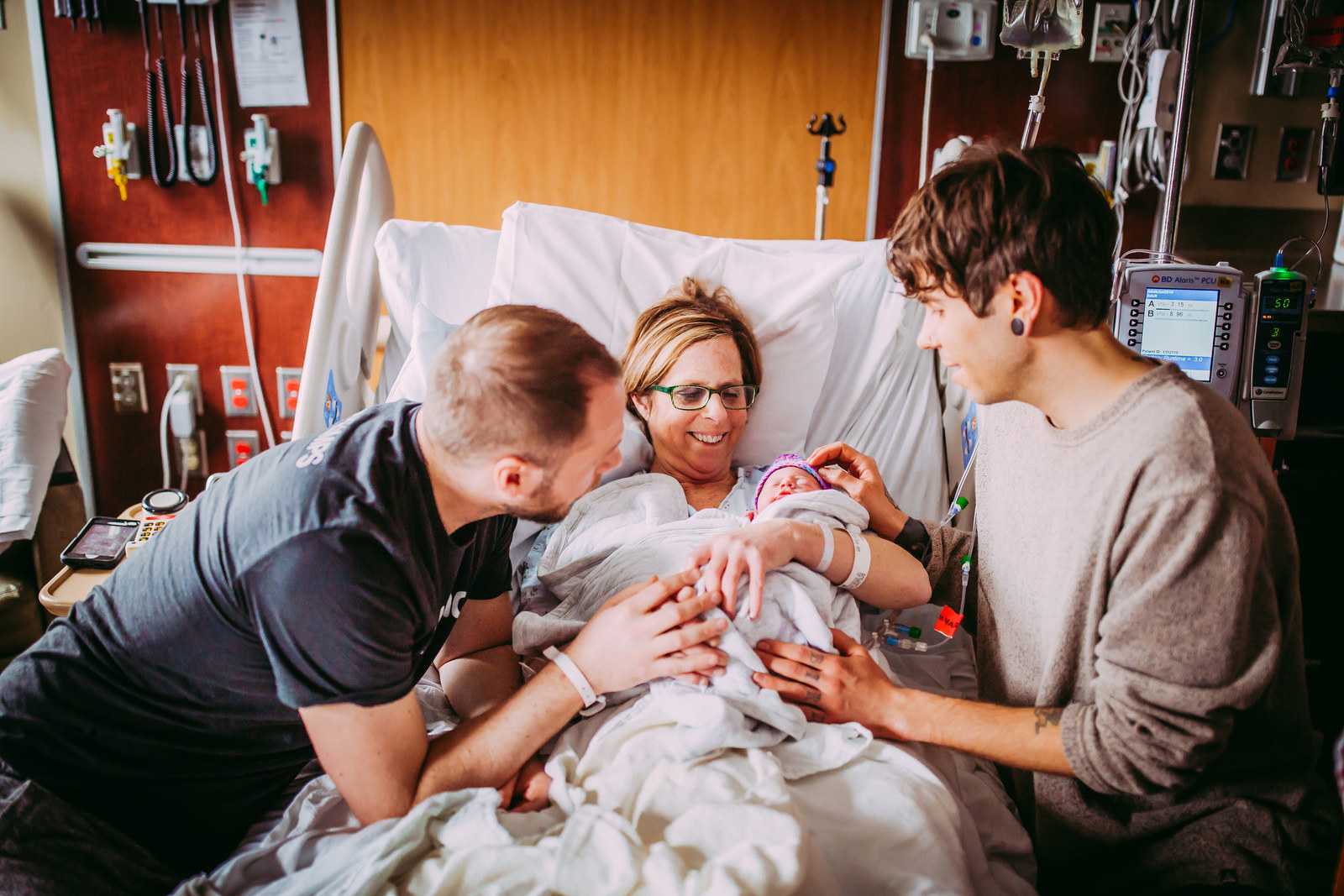
Cecile’s obstetrician, Dr. Ramzy Nakad at the University of Nebraska Medical Center, told me that he and his team have worked with many women over the age of 35, all of whom are considered a higher-risk pregnancy. “A lot of patients we see are of advanced maternal age,” he said. But Cecile, at 61, was “definitely a very exceptional case.”
For all pregnancies in people over 35, there are “greater risks of adverse obstetrical outcomes,” Nakad said. There are considerations to be taken for the person carrying the fetus, like a higher risk of preeclampsia. But since Cecile was a surrogate, the risk of genetic abnormalities that’s normally a concern for the fetuses of older pregnant people wasn’t an issue.
“When I offered to do this, I didn’t do this to be the center of attention. It was just my natural instinct to offer.”
Besides the normal precautions taken for any high-risk pregnancies, Nakad has no particular concerns about a woman Cecile’s age giving birth, even when it comes to delivering vaginally, which “in any pregnancy is always the aim,” he said, because it means a better recovery for both the mom and the baby.
“They’d say, ‘We don’t have a textbook on 61-year-olds having a baby,” Cecile laughed. “But everything seemed good — they were just cautious.” People in her life couldn’t believe she’d have a vaginal birth, but she said her doctors assured her that’s what they were shooting for, “And that we’d know day-of.”
This past weekend, Cecile was induced, following a worrying spike in her blood pressure. But about 12 hours later, Cecile delivered the baby without a C-section, and all was well: She and Uma are both exhausted, but healthy and happy.
I video-chatted with the family while they were preparing to leave the hospital Monday morning. “I feel fabulous!” Cecile said, and she looked it.
Elliot was lying down with Uma, his shirt off so that the baby would benefit from skin-to-skin contact. Matthew and his parents sat together, chatting amiably, at his bedside.
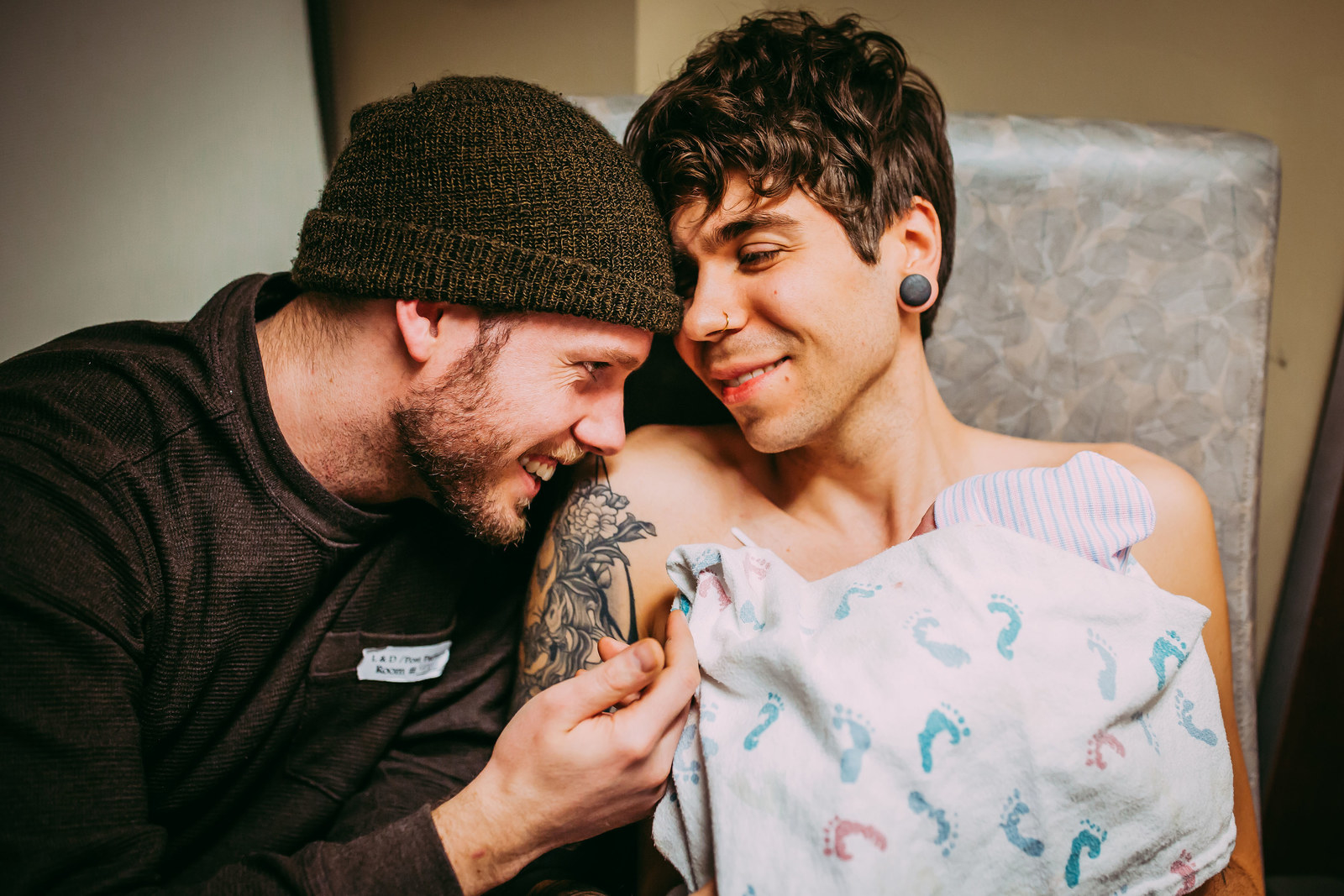
I asked if the couple planned on staying in Omaha long term, and Matthew joked that “Grandma wouldn’t allow us to leave.”
“That was in the contract,” said Cecile.
Joking aside, Matthew thought back to the last time he’d been in the news — when he was fired from his teaching job for being gay — and how much that incident really highlighted the challenges of living in Nebraska as gay people. “Politically, things haven’t always been in our favor here,” he said. “Elliot and I thought this wasn’t necessarily a place to raise a family as a gay couple, but we value family so much — here, we have a close-knit community. And that makes it a really good place to live.”
He mentioned that one of his friends who’d also recently had a baby has been stockpiling and freezing her breast milk for Uma. “Talk about a support system! This is a friend we trust and love. We love women — we think women should rule the world. Elliot’s sister donated her eggs, my mom carried her, and we have this dear beautiful friend giving her this nourishment. Our daughter, Uma, gets to be surrounded by all these smart, beautiful, compassionate women.”
Even with that support system, it may not all be smooth sailing for the family from here.
“People didn’t understand at first, but once they do, they’re ridiculously supportive — they think it’s radical and amazing. They’re really inspired by my mom.”
“It’s kind of embarrassing,” Matthew said. “My mom and I are legally Uma’s parents. Nebraska requires the sperm donor to be the father and the person who delivers the baby to be the ‘mother,’ even if she’s not biologically related to the child. This looks really creepy for us. Let’s just say we will NOT be framing and hanging up Uma’s birth certificate. I thought Elliot could at least put his name on the birth certificate, at least symbolically, but they didn’t even offer that. He now needs to go through an adoption process to get any legal rights. We plan on doing that, but let’s pretend in the meantime, since this can be a tedious process, god forbid, I were to die: Elliot would have absolutely no legal custody for our daughter.”
“We have gay marriage, but we have an entire structure that hasn’t caught up,” he added.
But all of this has been worth it for baby Uma. Elliot brought her over to the video chat for me to see her: a sweet little bundle in a purple knit hat.
“She just kinda lays there. It’s so cliché because everyone says it,” Matthew said, laughing, “but seeing her — it’s so hard to explain. I just want to stare at her. I’m looking at her — and this has been a two-year process. It was all a theory. But then through creation and creativity and imagination and dreams, she became a thing, a physical thing. That’s when I think I lost it, when I realized she’s no longer a thought, an idea. She’s here! We did this. We all did this together.” ●

